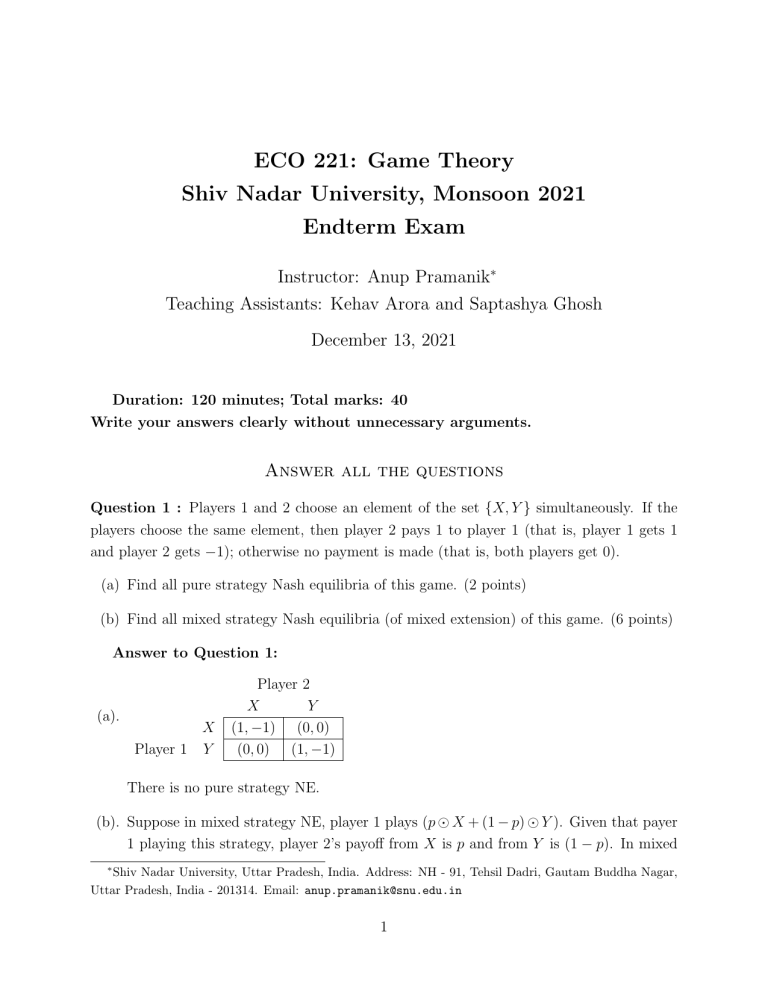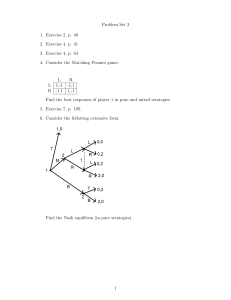
ECO 221: Game Theory
Shiv Nadar University, Monsoon 2021
Endterm Exam
Instructor: Anup Pramanik∗
Teaching Assistants: Kehav Arora and Saptashya Ghosh
December 13, 2021
Duration: 120 minutes; Total marks: 40
Write your answers clearly without unnecessary arguments.
Answer all the questions
Question 1 : Players 1 and 2 choose an element of the set {X, Y } simultaneously. If the
players choose the same element, then player 2 pays 1 to player 1 (that is, player 1 gets 1
and player 2 gets −1); otherwise no payment is made (that is, both players get 0).
(a) Find all pure strategy Nash equilibria of this game. (2 points)
(b) Find all mixed strategy Nash equilibria (of mixed extension) of this game. (6 points)
Answer to Question 1:
(a).
Player 1
X
Y
Player 2
X
Y
(1, −1) (0, 0)
(0, 0) (1, −1)
There is no pure strategy NE.
(b). Suppose in mixed strategy NE, player 1 plays (p X + (1 − p) Y ). Given that payer
1 playing this strategy, player 2’s payoff from X is p and from Y is (1 − p). In mixed
∗
Shiv Nadar University, Uttar Pradesh, India. Address: NH - 91, Tehsil Dadri, Gautam Buddha Nagar,
Uttar Pradesh, India - 201314. Email: anup.pramanik@snu.edu.in
1
strategy equilibrium, it must be the case that p = 1 − p. Therefore, p = 21 . Hence, in
mixed strategy NE, player 1 plays ( 12 X + 12 Y ).
Similarly, in mixed strategy NE, player 2 plays ( 12
X+
1
2
Y ).
Question 2 : Let Γ be the following strategic form game.
Player 2
Player 1
a
b
B
(2, 1)
(2, −20)
A
(3, 0)
(−10, 1)
C
(−100, 2)
(3.3)
(a). Find all pure strategy Nash equilibria in Γ. (2 points)
(b). Is there a unique maxmin equilibrium in Γ? If yes, find it. If not, find the set of all
maxmin equilibria in Γ. (3 points)
(c). Show that if a player has a weakly dominant strategy, then it is a maxmin strategy. (3
points)
Answer to Question 2:
(a). (C, b) is the unique pure strategy NE.
(b). B is the unique maxmin strategy for player 1 and a is the unique maxmin strategy for
player 2. Therefore, (B, a) is the unique maxmin equilibrium.
(c). Let Γ = (N, {Si }i∈N , {ui }i∈N ) be a strategic form game. Suppose si ∈ Si is a weakly
dominant strategy. We will show that si is a maxmin strategy.
For any si ∈ Si , let v(si ) = mins−i u(si , s−i ). Since si is a weakly dominant strategy,
v(si ) ≥ v(s0i ) for all s0i ∈ Si . Therefore v(si ) is the maxmin value of player i and si is a
maxmin strategy.
Question 3 : Consider a used car market in which a car is in good condition with
probability 0.5 and and in bad condition with probability 0.5. There is one buyer an one
seller. The seller knows whether the the car is good or bad but the buyer does not know the
quality of the car.
The seller has two possible actions: sell (S) and not sell (NS). The buyer has two possible
actions: buy (B) and not buy (NB). If the car is good, then the game in Table 1 is played.
If the car is bad, then the game in Table 2 is played.
2
Player 2 (Seller)
B
Player 1 (Buyer) N B
S
NS
(3, 3)
(0, 5)
(0, 5)
(5, 5)
Table 1: Good Car
Player 2 (Seller)
B
Player 1 (Buyer) N B
S
NS
(1, 3)
(0, 0)
(0, 0)
(0, 0)
Table 2: Bad Car
(a) Find the strategy set of Player 1 and Player 2. (3 points)
(a) Find the Bayesian equilibria of this game. (5 points)
Answer to Question 3:
(a). Player 1 (buyer) has two strategies - B and N B. Player 2 (seller) has four strategies s1 , s2 , s3 and s4 where
s1 (Good Car) = S and s1 (Bad Car) = S
s2 (Good Car) = N S and s2 (Bad Car) = N S
s3 (Good Car) = S and s3 (Bad Car) = N S
s4 (Good Car) = N S and s4 (Bad Car) = S
(b). Note that
u1 (B, s1 ) = 3 × .5 + 1 × .5 = 2
u1 (B, s2 ) = 0 × .5 + 0 × .5 = 0
u1 (B, s3 ) = 3 × .5 + 0 × .5 = 1.5
u1 (B, s4 ) = 0 × .5 + 1 × .5 = .5
u1 (N B, s1 ) = 0 × .5 + 0 × .5 = 0
u1 (N B, s2 ) = 5 × .5 + 0 × .5 = 2.5
u1 (N B, s3 ) = 0 × .5 + 0 × .5 = 0
u1 (N B, s4 ) = 5 × .5 + 0 × .5 = 2.5
and
3
u2 (B, s1 ) = 3 × .5 + 3 × .5 = 3
u2 (B, s2 ) = 5 × .5 + 0 × .5 = 2.5
u2 (B, s3 ) = 3 × .5 + 0 × .5 = 1.5
u2 (B, s4 ) = 5 × .5 + 3 × .5 = 4
u2 (N B, s1 ) = 5 × .5 + 0 × .5 = 2.5
u2 (N B, s2 ) = 5 × .5 + 0 × .5 = 2.5
u2 (N B, s3 ) = 5 × .5 + 0 × .5 = 2.5
u2 (N B, s4 ) = 5 × .5 + 0 × .5 = 2.5
Strategic form (in matrix) is represented below:
B
Player 1 (Buyer) N B
Player 2 (Seller)
s1
s2
(2, 3)
(0, 2.5)
(0, 2.5) (2.5, 2.5)
s3
(1.5, 1.5)
(0, 2.5)
s4
(.5, 4)
(2.5, 2.5)
(N B, s2 ) and (N B, s4 ) are Nash equilibria - which are indeed Bayesian equilibria.
Question 4 : Consider the following game played between players 1 and 2. Player 1
moves first and plays either L or R. This is is observed by both the players. If L is played,
players 1 and 2 simultaneously choose from the sets {l, r} and {t, d} respectively and the
game ends with payoffs (3, 1), (0, 0), (0, 0) and (1, 3) if (l, t), (l, d), (r, t) and (r, d) are played
respectively. If Player 1 plays R, players 1 and 2 simultaneously choose from the sets {m, n}
and {q, s} respectively and the game ends with payoffs (2, 2), (0, 0), (0, 0) and (0, 0) if (m, q),
(m, s), (n, q) and (n, s) are played respectively.
(a) Represent this game in extensive form (draw the game tree only). (3 points)
(b) Find all subgame perfect equilibria (SPE) of the game. (5 points)
Answer to Question 4:
4
Question 5 : Consider the following bargaining problem: 20 lakh rupees needs to be
split between X and Y. Y gets to make an initial offer. X then gets to respond by either
accepting or rejecting Y’s initial offer. If X accepts, the game ends and the initial offer would
be their pay-off. If X rejects, then the game moves to the second period where X makes an
offer. In the second period, Y has two choices- either accept or reject X’s offer. If the offer
is accepted, then X’s offer would be the pay-off. Otherwise, both are getting 0. Y’s discount
rate is 0.8 and X’s discount rate is 0.9.
(a) Represent this game in extensive form (draw the game tree only). (3 points)
(b) Find subgame perfect equilibrium (SPE) of this bargaining game. (5 points)
Answer to Question 5:
5
6


